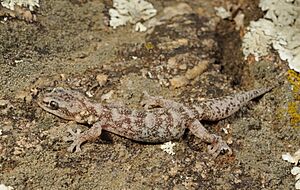European leaf-toed gecko facts for kids
Quick facts for kids European leaf-toed gecko |
|
|---|---|
 |
|
| Conservation status | |
| Scientific classification | |
| Genus: |
Euleptes
|
| Species: |
europaea
|
| Synonyms | |
|
Phyllodactylus europaeus Gené, 1839 |
|
The European leaf-toed gecko (also known as Euleptes europaea) is a small lizard. It belongs to the gecko family Sphaerodactylidae. You can find this gecko in places like France, Italy, and Tunisia. It also lives on many islands in the Mediterranean Sea. These geckos love to live in rocky areas and along rocky coastlines.
Contents
About the European Leaf-Toed Gecko
The European leaf-toed gecko is usually about 6 centimetres (2.4 in) (about 2.4 inches) long. Some can grow a bit bigger, up to 8 centimetres (3.1 in) (about 3.1 inches). Its head looks like a diamond and is wide and flat. It has large eyes with pupils that are vertical slits, like a cat's.
Its body is a bit plump, and its legs are short. This gecko has special sticky pads on its square-shaped toes. It also has a sticky pad on the tip of its tail! These pads help it climb really well. Its tail is usually as long as its body. If the gecko loses its tail and grows a new one, the new tail can be twice as thick.
The gecko's skin feels a little bumpy but does not have large bumps called tubercles. This helps tell it apart from other geckos in Europe. Its color can change a lot. It might be yellowish-brown or grayish-brown. It often has patterns and blotches of yellow, sometimes in stripes. Like other geckos, it can change its color. It becomes lighter when it's hot and darker when it's cooler.
Where These Geckos Live
You can find this gecko on islands like Corsica and Sardinia. It also lives on other Mediterranean islands, including some near Tunisia. You might also see them in a few places along the coast in southern France. They are also found in Tuscany in central Italy.
These geckos are hard to spot because they are mostly active at night. They like to live on rocks, walls, and cliffs, especially those made of granite. They don't often live inside buildings where people are. But you might find them in old ruins or sometimes on tree trunks.
They usually live in lower areas. However, when it's warmer, they can be found high up, even at about 1,500 metres (4,900 ft) (about 4,900 feet) above sea level. During the day, they hide behind loose rocks or in cracks. In some places, many geckos can live close together.
Life Cycle and Reproduction
The European leaf-toed gecko sleeps through the winter, which is called hibernation. It wakes up when the weather gets warm in the spring.
When it's time to lay eggs, the female usually lays two eggs. She sticks them inside a crack in a rock. The eggs take about eight to thirteen weeks to hatch. When the baby geckos come out, they are about 3 centimetres (1.2 in) (about 1.2 inches) long. They become adults when they are two or three years old. These geckos can live for up to twenty years!
Gecko Behavior
Euleptes europaea is a very quick and nimble gecko. It can jump quite far! It eats insects and other small creatures without backbones, called invertebrates. It often hunts its prey by moving very slowly. Then, it makes a quick leap to catch its meal.
During the day, it might warm itself in the sun on rocks. Its colors help it blend in perfectly, which is called camouflage. This helps it hide from animals that might want to eat it, like birds and snakes.
These geckos have special "leaf-padded" feet. These feet are better at gripping surfaces, even when there is dust. Other types of geckos have different kinds of footpads. The leaf-toed gecko can lift its toe-tip pads if they get dusty. This allows it to use its claws to climb instead. Other geckos, like the Tarentola mauritanica, cannot do this. This special ability helps the European leaf-toed gecko live in dusty places where other geckos cannot.
See also
- List of reptiles of Italy


